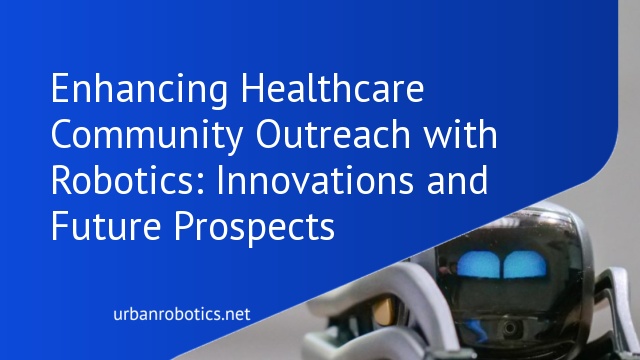Understanding Healthcare Community Outreach
Healthcare community outreach aims to improve health outcomes by bringing services directly to community members. Outreach initiatives focus on marginalized and underserved populations. These programs provide preventive care, health education, and treatment services. By engaging communities, we address health disparities and increase accessibility to essential services.
Effective community outreach involves collaboration among healthcare providers, local organizations, and community leaders. Partnerships help identify specific health needs and tailor interventions accordingly. We leverage resources and strengths within communities to foster trust and promote health literacy.
Robotics enhances outreach efforts by increasing efficiency and reach. Automated systems perform tasks like medication delivery and chronic disease monitoring. This tech reduces the burden on healthcare workers, allowing us to serve more patients. By integrating robotics into outreach programs, we ensure high-quality care reaches everyone, regardless of location.
The Role of Robotics in Healthcare
Robotics plays a critical role in enhancing healthcare delivery, particularly in community outreach. The integration of robotics ensures high-quality care is accessible to underserved populations.
Advancements in Medical Robotics
Medical robotics has seen significant advancements. Robots now perform complex surgeries with precision, improving patient outcomes. Autonomous robots aid in medication dispensing, ensuring accurate dosages. Telepresence robots connect patients with specialists remotely, facilitating timely consultations. These innovations enhance the capabilities of healthcare professionals and extend their reach.
Benefits of Robotics in Community Outreach
Robotics offers numerous benefits in community outreach. Automated drones deliver medications to remote areas, ensuring timely access to essential drugs. Robots equipped with telehealth technology provide consultations in underserved communities, bridging gaps caused by geographic barriers. By automating routine tasks, robotics reduces the burden on healthcare workers, allowing them to focus on patient care. This ensures efficient, effective interventions, promoting public health.
Case Studies of Successful Implementations
Various successful implementations highlight the transformative power of robotics in healthcare community outreach, showcasing tangible benefits across different regions.
Rural Healthcare Access Improvement
Robotics has enhanced rural healthcare access, especially in remote regions. We observed automated drones delivering medications and medical supplies to indigenous communities in Alaska. Telehealth-equipped robots facilitated consultations, reducing travel time for patients and doctors. In India, robotic health assistants conducted routine check-ups, collecting vital data for healthcare professionals based in urban centers. These initiatives demonstrate how robotics can bridge gaps in rural healthcare, bringing essential services to hard-to-reach locations.
Urban Healthcare Initiatives
Urban healthcare initiatives leveraging robotics have focused on improving service delivery and efficiency. In New York City, telepresence robots enabled specialists to consult with patients in congested hospital settings, optimizing appointment schedules. Automated medication dispensers in San Francisco clinics reduced prescription errors and waiting times. Robotics-assisted public health campaigns in Los Angeles also increased vaccination rates and health awareness. These implementations show how robotics can address unique challenges in urban healthcare, enhancing overall service quality.
Challenges and Solutions
Technical and Logistical Challenges
Integrating robotics into healthcare outreach presents technical and logistical challenges. Robot deployment in rural or remote areas requires reliable internet connectivity, which is often inconsistent in such regions. Additionally, maintaining and servicing robots can be difficult due to limited local expertise and resources. Training healthcare professionals to effectively use robotics technology also demands significant time and effort.
Ethical and Privacy Concerns
Ethical and privacy concerns arise when using robotics for community healthcare. Data collected by robots must be securely stored and transmitted to protect patient confidentiality and comply with regulations like HIPAA. Ethical considerations include ensuring equitable access to robotic healthcare services regardless of socio-economic status. There must also be transparency around how data is used to gain public trust in robotic systems.
Future Prospects and Innovations
Incorporating robotics into community healthcare outreach shows promising advancements and potential future growth. Let’s delve into the emerging technologies and their impacts on healthcare delivery.
Emerging Technologies
New robotics technologies, including AI-driven diagnostic tools and robotics-assisted rehabilitation, are revolutionizing healthcare. AI algorithms analyze patient data swiftly, enabling early detection of diseases. Robotics-assisted rehabilitation devices, like exoskeletons, enhance mobility recovery for patients with spinal injuries. Autonomous delivery robots expedite medicine and supply distribution in hospitals. These innovations streamline processes, reduce human error, and improve overall healthcare efficiency in community outreach settings.
Potential Impacts on Healthcare Delivery
Integrating advanced robotics can elevate healthcare delivery standards. Autonomous robots enhance remote diagnostics, increasing access in underserved areas. AI-driven predictive analysis helps healthcare providers anticipate and manage chronic conditions better. Robotics-assisted surgery, enabling minimally invasive procedures, shortens recovery times and reduces complications. Implementing these technologies can lead to a more effective, responsive, and equitable healthcare system, especially in community outreach programs targeting both urban and rural populations.
Conclusion
Healthcare community outreach with robotics is transforming our approach to delivering medical services. By leveraging advanced technologies like AI-driven diagnostics and autonomous robots we’re bridging gaps in healthcare access and improving patient outcomes. These innovations are not just enhancing efficiency but also ensuring that underserved populations receive the care they need.
As we continue to integrate robotics into our healthcare systems we’re paving the way for a more equitable and effective future. With ongoing advancements and a focus on addressing ethical concerns we can look forward to a new era in community healthcare outreach. This progress promises to make high-quality healthcare accessible to all regardless of their location.





